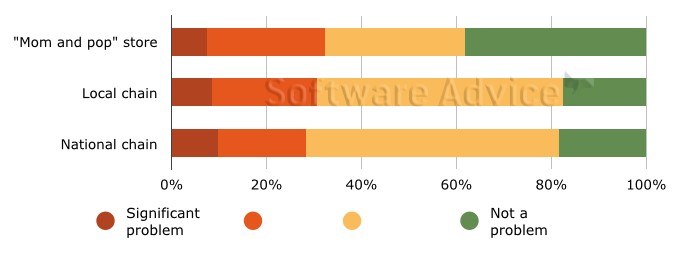Several years ago we wrote the blog post: Ten Signs Your Company is Ready for an Inventory Management System. Are you still trying to get by without an inventory management system? Well, here’s further proof that inventory management software can help your business.
In a recent report released by Forrest Burnson at Software Advice, a digital consultancy, there is evidence that theft can be prevented with the use of an inventory management system. Having done a comprehensive study*, here are the key findings they came up with:
- Twenty-eight percent of employees whose stores use inventory management software say internal theft is a problem, compared to 37 percent of those whose stores use other methods for managing inventory.
- Fifteen percent of employees whose stores use inventory management software admit to stealing from their store, versus 22 percent of employees whose stores use other methods.
- Only 37 percent of small “mom and pop” stores are using inventory management software, versus 53 percent of local and regional retail chains and 85 percent of national retail chains surveyed.
I had the opportunity to ask Forrest some questions about this report, and he weighed in on the subject for Red Wing Software customers. Here’s what he had to say.
Question:
Does inventory management software actually deter theft?Answer:
“While a computer program won't necessarily deter employee theft, it will give you the resources to ensure that your inventory is properly accounted for. When your inventory is properly accounted for on a consistent basis, there's less of a chance that bad behavior will be able to fly under the radar.”
Question:
What kind of business can benefit the most from moving to inventory management?Answer
“Regardless of what kind of business you have, it's important to protect your assets. From small businesses to larger enterprises, every company can benefit from implementing inventory management software. As you can see in the below graphic from our report, at least 60% of respondents from each type of store see employee theft as a problem to some degree. Using this software is an easy way to give you a better sense of security."
Question:
What is the most significant improvement businesses experience when moving from paper and pencil to inventory management software?Answer:
"It's important for item-based small business owners to realize that while inventory management software might seem unnecessary or time-consuming to maintain, it will actually save you time—and money—in the long run. It increases your inventory visibility by standardizing your records and it can help you identify where shrinkage is occurring when you perform cycle counts."
Researcher Bio

Forrest Burnson is a Market Research Associate at Software Advice, where he covers the construction, inventory management and supply chain markets. He graduated in 2011 from the University of the South with a degree in political science and French studies. In 2013, he graduated from the University of Texas with a master’s degree in journalism. During his second year of graduate school, Forrest was a fellow for News21.
Prior to joining Software Advice, he was a writer and researcher for Global Water Intelligence. He has also written for a number of other outlets, including the Texas Tribune, the Austin Business Journal, Market News International and the Austin American-Statesman.
*To find the data in the mentioned report, Software Advice conducted a seven-day online survey of six questions, and gathered 385 responses from random retail employees within the United States. All survey questionnaires undergo an internal peer review process to ensure clarity in wording. If you have comments or would like to obtain access to any of the charts above, please contact forrest@softwareadvice.com.
Many businesses start out with basic financial management software, or bookkeeping software consisting of general ledger, accounts payable and accounts receivable. As the business grows, managing inventory becomes essential to the profitability of the business. Three software modules work together to provide excellent inventory management: inventory, order entry, and purchase orders. What are the signs your business is ready to start looking at an inventory management system?
- You sometimes forget to ship backordered items. Without a system to track items on backorder, it can be easy to forget to ship those backordered items. An order entry system allows you to ship the items that are available, and keep track of those unshipped items, so you won’t forget to ship them once available.
- You are unsure about when to re-order, and how many of each item to keep in stock. With an inventory system, you can run reports that show demand for each item within the time period you choose, so you’ll know when you are running low, and have a gauge for how many to keep in stock. For example, in the busy sales months you can maintain inventory levels for your customers, but in the slower sales cycle you won’t have a shelf full of obsolete items.
- You are unsure which items you sell are the most and least profitable. One item seems to be flying off the shelf, while another has minimal sales revenue. Not knowing of which of those two items is more profitable is a huge mistake. If the slow seller is more profitable, a smart idea would be to focus on increasing sales to improve overall profitability.
- When a customer places an order, you cannot tell whether those items are in stock. If you constantly have to walk back to the warehouse or call somebody to physically check on the stock status of an item, you are doing your customer and yourself a disservice. Checking stock manually wastes your employees’ time. It can also result in broken promises or delayed shipping to your customer. Adding a computerized system for checking inventory can greatly enhance your customer satisfaction, and can improve the efficiency of your business.
- You have different pricing levels for your products which are currently accessed from a paper file. If you are keeping pricing information on paper, it can be hard to tell which pricing is the most current, and sometimes the correct sheet can even disappear. Having your software keep track of multiple pricing levels is a much more secure and organized way to keep track of pricing. By assigning each customer their respective price level, your orders will automatically show correct pricing when the order is entered into the system.
- Order entry and order invoicing are currently done in two separate systems. If you have one system to keep track of orders, and another separate system for entering the accounts receivable invoice, you are spending double the time entering the same information. You can save time and reduce manual errors by electronically entering orders and creating invoices.
- Do you have items that can be sold in different units of measure? For instance, you get a discount for purchasing items by the pallet, but your customer buys them by the carton. Having an inventory management system allows you to receive the items in the unit of measure you choose (in this case, by the pallet) and then sell in another unit of measure (i.e. by the carton). The system will also keep track of the item’s purchase price, and the cost of goods sold, in the unit of measure specified.
- You track serial or lot numbers on paper or in a spreadsheet. You are tracking serial or lot numbers for a reason, and that reason is to keep track of who got which items, in case of a faulty lot or recall. Having the information on paper can be risky because papers can get lost or damaged. An inventory system allows you to track this information electronically, so you can always run a report to see who got what.
- Are you wondering why your profitability is down? With inventory management, you can run reports by item, product line, or sales category showing each item’s profitability, so you’ll know along the way the trend for each of the items you sell. That way you can fix the problem early and maintain your profitability.
- Your inventory is running you! The right inventory accounting software can provide the tools your business needs to increase efficiency, provide excellent customer service, and help you to take control of your financial management.